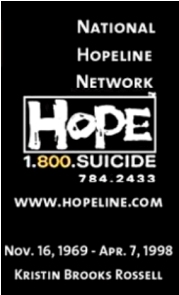Statistics
Let’s take a look at some updated Suicide Statistics:
- World Health Organization (WHO) reports that 1,000,000 deaths occur worldwide by suicide; women attempt suicide more than men do, however, there is a higher percentage of successful suicides by men versus women. The reason behind this is believed to be the means used by men are more "lethal" than the means used by women. However, the trend is changing.
- That translates to 1 person dies, by suicide, every 40 seconds globally; this represents a 60% increase of suicide rates during the last 45 years (WHO).
- World Health Organization (WHO) reports that suicide rates within "young people" have dramatically increased over the last years and are now considered "the highest risk" group among developed and undeveloped countries.
- In 2005, the United States suicide rates were 11.1 for every 100,000 people (WHO). In 2008, the United States suicide rates increased to 11.84 for every 100,000 people. This translates to 36,035 deaths by suicide (CDC).
- Florida ranked #15 out of the 50 states for the highest suicide rates in 2008 (AAS), and #3 as the highest State (after PA and CA) for the highest suicide deaths between the ages of 15-24 (AAS). Suicide is considered to be the second leading cause of death for college students and for people aged 25-34 (AFSP).
- Suicide is the third leading cause of death for people between the ages of 10-24 (AFSP).
- From 1981-2008, 864,271 people died by suicide, whereas 454,536 died from AIDS and HIV-related diseases (AFSP).
These are documented statistics. Several organizations that specialize in suicide prevention (Jason Foundation, Hopeline, etc.) believe that these statistics are low in comparison to the true numbers, as some fatalities are not reported as suicides.
Sources:
- World Health Organization, Suicide Prevention (SUPRE)
- US States Suicide Rankings, American Association of Suicidology
- American Foundation for Suicide Prevention
Is Suicide preventable?
According to the American Psychological Association, teen suicide IS preventable. The article discusses various risk factors and stressors that can lead a teenager to attempt suicide, with “mental illness being the leading cause” (APA). The article also describes the type of prevention strageties that can be put in place, including mental health screening, education and awareness.
World Health Organization states that “suicide is huge but preventable health problem.”
The National Hopeline writes “Depression is the leading cause of suicide……depression is treatable and as a result, suicide is preventable.”
Bottom line, suicide IS preventable, based on research conducted by health professionals and experts in the field. For prevention to be successful, education and training in detecting the early signs of suicide, along with providing the needed resources for treatment, is required especially within school communities. Bradford was highly intelligent and manipulative in the manner in which he masked his symptoms at home. His brother and sisters never imagined he would commit such an act of taking his life. However, during our own investigation, we found out from several of his friends and after his death that he “occasionally” made statements, in school, about dying. If even one of his friends would have approached us, or talked in private with a school counselor, Bradford would be alive today. If his two friends that texted at length with him the night before he died would have called the police, or us, or a suicide hotline, Bradford would be alive today. Why? Because suicide is preventable, and there is plenty of evidence from experts in the field to support such claim.
We “want to trust” our children; this is the way it “should” be. As parents we want to confide in our child and believe the “I’m fine, mom” statements, and we should. However, Ronald Regan once said, “Trust, but verify.” Suicide education and training should be made a part of every school curriculum on a routine basis and a regular family topic of discussion. We teach our children to read, do math, and write. We need to teach our children consistently about how to save a life, possibly theirs. Prevention begins with each of us. Visit our Resources page to find out how you can learn about Suicide Prevention Education and the resources available to you, your family and our schools.
Oath of Guardianship©
"My friend, I love you. I promise to always watch over you even during your darkest moments; if you need help, I will make sure to find help for you, even if you ask me not to. I promise to not honor any bonds that will ultimately hurt you in any way; it's for your own good. Understand, as a loving friend, it is my responsibility to watch over you. I promise not to let you think that your life is worthless and to dishonor you. YOU MATTER TO ME AND TO THE WORLD; YOU ARE WORTHY OF GOD'S LOVE AND LIFE."


Bradford's Pledge, written by Ana Fernandez
January 21, 2011







